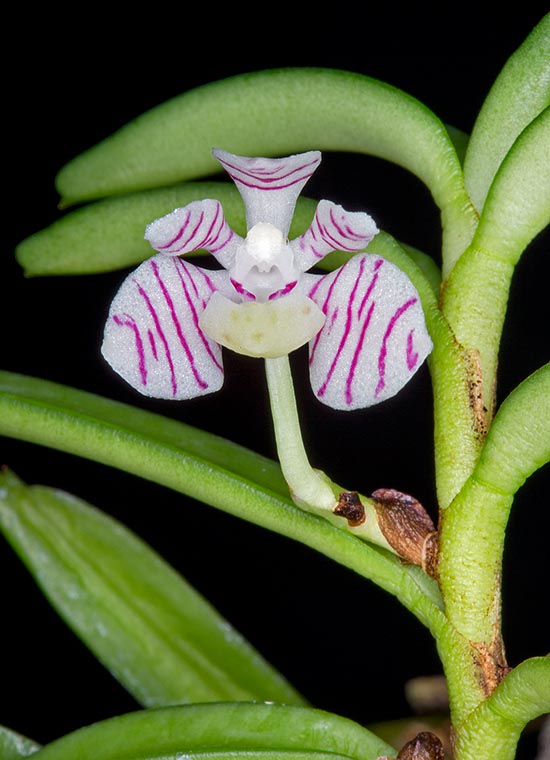Family : Orchidaceae

Text © Pietro Puccio

English translation by Mario Beltramini

Miniature orchid, among the most appreciated and cultivated of the genus due to the small size and the attractive and scented flowers, Trichoglottis pusilla is native to Java and Sumatra humid forests. It grows epiphyte between 700 and 2200 m of altitude with 8-15 cm stems and flowers of 1,5-2,5 cm, pleasantly perfumed, with ovate sepals of white colour with purple streakings © Giuseppe Mazza
The name of the genus is the combination of the Greek substantives “θρίξ” (thrix) = hair and “γλῶττα” (glotta) = tongue, with reference to the down present on the labellum; the specific name is the Latin adjective “pusillus, a, um” = teeny, with reference to the small size of the plant.
Common names: tiny trichoglottis (English).
The Trichoglottis pusilla (Teijsm. & Binn.) Rchb.f. (1856) is a epiphytic monopodial species with cylindrical erect stems covered by the imbricate foliar bases, 8-15 cm long, provided of alternate leaves, distichous, nastriform with irregularly bilobed apex, 3,5-12 cm long and 1 cm broad, coriaceous, of intense green colour. Axillar inflorescences, on an about 2 cm long peduncle, bearing 1-3 flowers, of 1,5-2,5 cm of diameter, pleasantly perfumed, with ovate sepals of white colour with transversal purple streakings, oblong-lanceolate petals, of the same colour as the sepals, and obovate labellum with emarginate apex, thick, fleshy, of greenish white colour spotted of purple.
It reproduces by seed, in vitro, and through the young plants that eventually it produces at the base.
Miniature orchid, among the most appreciated and cultivated of the genus due to the reduced size and the attractive and perfumed flowers, of easy cultivation, requires a slightly shady position, medium-high temperatures, 22-30 °C in summer, but with a good daily thermal excursion to stimulate the blooming, slightly cooler in winter, with lowest night values not under the 15 °C, high humidity, 70-85%, and constant ventilation. The waterings must be regular and abundant, but allowing the substratum to slightly dry up before giving water again, more spaced in winter, with average lower temperatures, but always maintaining a minimum of humidity, utilizing rain water, demineralized or by reverse osmosis. It can be mounted on trunks, bark, rafts of cork or of arborescent ferns with sphagnum at the base, or cultivated in pot with a compost that may be formed by medium sliced bark fragments and sphagnum. The repottings are to be done at the vegetative restart when the substratum shows signs of deterioration.
The species is reported in the appendix II of CITES (species whose trade is internationally ruled).
Synonyms: Vanda pusilla Teijsm. & Binn (1853); Trichoglottis cochlearis Rchb.f. (1883); Trichoglottis pusilla f. fatoviciana Choltco (2008).
→ For general notions about ORCHIDACEAE please click here.
